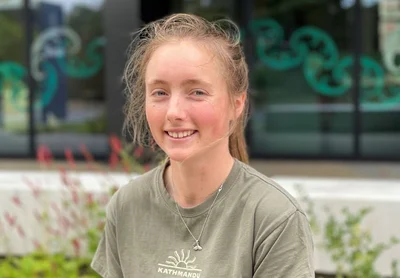Saving our native lizards

From a Mid Canterbury farm to delving into the world of lizards, Samantha Fitzgerald is on track for a fascinating career. She talked to the Guardian after notching up a top local scholarship.
Samantha Fitzgerald, a recent Advance Ashburton scholarship recipient, will spend this year researching ways to help lizard conservation in New Zealand.
The 22-year-old is a Mt Hutt College alumni in her final year of a two-year Master of Science degree at Lincoln University.
Her research and thesis will look at tools to help lizard conservation on farms and improve lizard monitoring conservation settings.
"We've got some very unique species of lizard in New Zealand. They're quite different. All but one local lizard species give birth to live young."
Fitzgerald said unlike the typical tropical species, New Zealand's lizards had specialised to survive in a colder climate with some distinct alpine-type species.
There were more than 130 lizard species in New Zealand with scientists still finding and describing new species, she said.
"About 86% of New Zealand's lizards are at risk and threatened."
Growing up on a sheep, beef and cropping farm just outside Methven, Fitzgerald was aware of geckos and skinks but only really started to appreciate them during her undergraduate studies at Lincoln.
She became aware of a gap in the tools available for lizard conservation.
There were tools for conservationists but nothing for farmers to monitor lizard populations on farms, she said.
As a result, Fitzgerald has come up with an "artificial retreat" for lizards, built from two layers of material, about a centimetre apart
Fitzgerald chose inexpensive materials commonly used on farms and is testing designs made from bricks, plywood sheets and corrugated roofing sheets to see which options work best - factoring in thermal properties and pest resistance.
She will test the lizard retreats on site on Cleardale Station above the Rakaia Gorge and on two farms on Banks Peninsula.
The retreats are a safe space for lizards to hang out and provide a snapshot of the lizards in an area and the health of the population.
If a number of lizards had short tails, it could work as a predator indicator and translate into pest control to help lizard populations.
Fitzgerald is also in the early stages of developing a lizard camera box for conservationists. She's got a camera box placed at Orana Wildlife Park for testing.
A motion sensitive or continuously recording camera would reduce the time and labour of monitoring lizards, particularly in remote areas, she said.
One of her more ambitious plans is to try and use the individual back pattern of geckos to identify and monitor individuals for more in-depth research.
Fitzgerald spoke at a conference for the Society of Research on Amphibians and Reptiles in New Zealand in November last year, where she received positive feedback on her research ideas.
Lizards play a crucial role in seed dispersal for native species and form part of an interconnected food web. Fitzgerald hopes her research will make a practical difference to lizard conservation.
When not working on her thesis, Fitzgerald works on a dairy farm in Leeston doing anything from odd jobs to milking and driving a tractor. She enjoys swimming, running and playing hockey. She's also into crotchet, knitting and cross stitch.
Once her thesis is finished, Fitzgerald plans to have "a bit of a gap year" with time for travel and walking the Te Araroa Trail before entering the workforce. Long-term, she hopes to run an ecological consultancy.
By Sharon Davis

